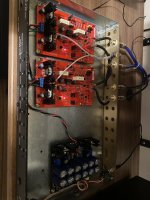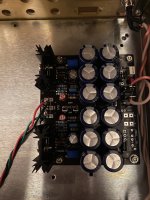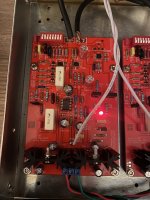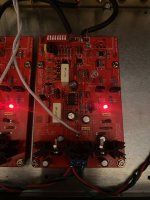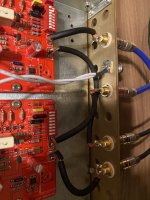They sounded fantastic, for what it’s worth… F6 is a great amp, yours were the best I’ve heard.
🙂
🙂
Hello Manolo47, BoydK and all others,
I have built the PEARL 1, PEARL 2, Aleph XONO-clone and now the PEARL 3 (in different variants = different JFets, OPAmps,...).
I still have all of these phonopres and I am still listening to all of them. They are all playing on a very high level.
To buy a commercial phonopre -of similar quality- you would have to spend a lot of money.
I do a lot of
It is always an adventure in sound.
If you have the money and time to build a PEARL 3 - do it. It is for me a 'giant-killer'. If you have one of the
other PEARLs or XONO it will be a slight step up. But perhaps not for you?
If you are playing in the highest class it is difficult to make it much better. In my opinion it is better - good recordings and the rest of your audio-system equally good...
In Germany we have a saying: 'As higher you raise into the air, as thinner the air gets'.
In other words: as better your components get, as more difficult it will be to make it better.
Cheers
Dirk 😉
I have built the PEARL 1, PEARL 2, Aleph XONO-clone and now the PEARL 3 (in different variants = different JFets, OPAmps,...).
I still have all of these phonopres and I am still listening to all of them. They are all playing on a very high level.
To buy a commercial phonopre -of similar quality- you would have to spend a lot of money.
I do a lot of
mixing. But it is time consuming to change a preamp, poweramp, loudspeaker,... in your setup.It is always an adventure in sound.
If you have the money and time to build a PEARL 3 - do it. It is for me a 'giant-killer'. If you have one of the
other PEARLs or XONO it will be a slight step up. But perhaps not for you?
If you are playing in the highest class it is difficult to make it much better. In my opinion it is better - good recordings and the rest of your audio-system equally good...
In Germany we have a saying: 'As higher you raise into the air, as thinner the air gets'.
In other words: as better your components get, as more difficult it will be to make it better.
Cheers
Dirk 😉
"In other words: as better your components get, as more difficult it will be to make it better."
Thank you for that evaluation 👍
Highly appreciated.
Funny to read your "sayings". If I remember correctly, you were the ones, that invented the word "Schlimmerverbesserung".
Take that..... capacitor changers 🤣🤣
Jokes aside. Great to hear your impression of the P-3. Have other projects at the moment, but almost can´t wait to get to the
Pearl-3.
Enclosures from Gianluca..... Check.
PCB´s...... Check.
Components........ Check.
Waiting on PSU-cable and XLR-connectors...... so very soon 😍
Thank you for that evaluation 👍
Highly appreciated.
Funny to read your "sayings". If I remember correctly, you were the ones, that invented the word "Schlimmerverbesserung".
Take that..... capacitor changers 🤣🤣
Jokes aside. Great to hear your impression of the P-3. Have other projects at the moment, but almost can´t wait to get to the
Pearl-3.
Enclosures from Gianluca..... Check.
PCB´s...... Check.
Components........ Check.
Waiting on PSU-cable and XLR-connectors...... so very soon 😍
It is good to hear my sweat paid off. Not that I can take real credit. We all know who...They sounded fantastic, for what it’s worth… F6 is a great amp, yours were the best I’ve heard.
🙂
I have used a Graham Azimuth tool in days gone by, but last time that I went to use it no joy. It seems to be a super simple and inexpensive way to do a good Azimuth adjustment.
Perhaps someone can chime in on how to make something like this. The idea is that you sum the 2 channels into mono inverting 1 leg. Then playing a monaural record with little extended highs you can adjust Azimuth till there is little to no output.
Perhaps someone can chime in on how to make something like this. The idea is that you sum the 2 channels into mono inverting 1 leg. Then playing a monaural record with little extended highs you can adjust Azimuth till there is little to no output.
I’m experimenting with a VRDN on a wall wart in a repurposed 1U chassis.
Unit fired up fine and works but trying to get it grounding correct and could use some recommendations. I have hum in the right channel when turntable ground is hooked up. If I remove it and ground to my preamp or headphone amp the hum goes away but I still get a little hiss and radio frequency in the right channel with volume turned up.
I’m wondering if isolating the power barrel connector, or isolating the turntable ground lug would fix my issue.
Any feedback is appreciated
Unit fired up fine and works but trying to get it grounding correct and could use some recommendations. I have hum in the right channel when turntable ground is hooked up. If I remove it and ground to my preamp or headphone amp the hum goes away but I still get a little hiss and radio frequency in the right channel with volume turned up.
- the ground input of the wall wart is connected to the chassis via barrel connector
- rcas grounds I isolated but show continuity with chassis.
- VRDN is set up for wall wart and on metal standoffs
- VRDN also has a 10 ohm resistor from chassis to ground.
- both Pearl boards are on metal standoffs
I’m wondering if isolating the power barrel connector, or isolating the turntable ground lug would fix my issue.
Any feedback is appreciated
Attachments
I think you should have only one reference from audio gnd to chassis?
You have two? one via a 10 ohm resistor at PSU board? and another via the two P3 boards to TT-ground post?
VRDN is the PSU board in chassis?
Not sure what VRDN means.......
You have two? one via a 10 ohm resistor at PSU board? and another via the two P3 boards to TT-ground post?
VRDN is the PSU board in chassis?
Not sure what VRDN means.......
The photos in the (VRDN Forum thread) show electrolytic capacitors tightly packed in a zig-zag configuration, but your PSU has got two straight rows of electrolytics with no zigging or zagging.
The actual VRDN with zig zag caps:

The actual VRDN with zig zag caps:
I just bought the boards from a member that had them made not knowing the layout was different. I used the same parts.
Hi you may want to check this out for a different opinion on how to set azimuth and possible issues with the summed mono method.I have used a Graham Azimuth tool in days gone by, but last time that I went to use it no joy. It seems to be a super simple and inexpensive way to do a good Azimuth adjustment.
Perhaps someone can chime in on how to make something like this. The idea is that you sum the 2 channels into mono inverting 1 leg. Then playing a monaural record with little extended highs you can adjust Azimuth till there is little to no output.
https://www.sound-smith.com/faq/how-do-i-set-azimuth-adjustment-my-cartridge
On original boards / schematic I was not able (by quick eye-catch) to find a 10 ohm reference from gnd to chassis (I might be wrong after a glass of red wine for the dinner).I just bought the boards from a member that had them made not knowing the layout was different. I used the same parts.
But you have it on your board?
From your post above:
- VRDN also has a 10 ohm resistor from chassis to ground.
If still hum I would try to make the "ground lift" only once place (from audio gnd (P3 board) to TT ground post).
Haha. You are correct! No wine can cloud your mind.
The 10 ohm resistor isn’t on the original boards and I’ve built a few of the original. The new board also has an added R23 and R24 I left blank.
Do I also need to isolate the input barrel from the chassis or is that ok as is?
The 10 ohm resistor isn’t on the original boards and I’ve built a few of the original. The new board also has an added R23 and R24 I left blank.
Do I also need to isolate the input barrel from the chassis or is that ok as is?
You need audio gnd to chassis reference (galvanic or via a resistor / NTC etc.) at one point and the gnd post probably a good place to do it. So I would keep it. It is also according to the build guide 🙂
sorry. I’m referring to the power input barrel for the wall wart and changing it to a plastic one. Not sure if that is needed or I can leave that.
Ok. so I've listened to the P3 with Burson V5, Burson V6 Vivid and the default LME49702 opamps.
Bear in mind my set up is still a prototype. Early version with not the best opamp sockets, and the wiring has not been fully been sorted out. It's also a one chassis with the PS to the left ( looking from the front ) of the boards.
Also, the chain is likely not optimal. It has too much gain. A lot of the issues with noise are due with the combination of the CJ preamp with the Macho XA252SIT. With the much lower gain SissySIT 42, noise is not as much of a problem
So...
I get background noise. Very low level, but it's there. It's related to the op amps. If I so much as take them out and reseat them again the noise changes.
If the unit is cold, I get a whistling noise. Seems to happen most with the Burson V6 Vivid. I have not seen this with the LME49702. The V5 is the new op amp in the game so I don't have enough time on it to have experienced it on a cold preamp.
When it powers up I get pops, peeps, whistle, etc.
On one occasion, with the V6, powering up from a cold state, the LEDs kept blinking, It took a couple of tries to get the preamp to power up correctly.
To wit, the V6 Vivid seems to be somewhat problematic, I've swapped them left to right and the problem is identical. I think the opamps are working fine but there likely needs some tweaking in the circuitry for them.
The LME49702 can be noisy. One of the opamps exhibits a wish-wish-wish "ocean wave" very low level noise. If I swap them L/R the noise goes with it.
The V5, so far are low noise.
If I tap the opamp, tap, tap, I get a low level base thump. It also changes if I reseat the opamps.
Bottom line, my prototype units have a mechanical issue with the opamp sockets. I've been told a better socket is available and soon I'll upgrade.
Sound..
Well, once the noises, thumps, wish-wish ocean waves, are settled and the unit has warmed up (I always let it warm up for at least half an hour)...
Turns out I'm a terrible audio critic. I get lost in the music and what should have been a one song, one snippet, ends up to be the whole side of the album.
But be as it may... the 49702 are definitely the most "accurate" sounding. There's is the most detail in the presentation. You can hear a very accurate mix, instruments and voices are clear and in place and separate. Great soundstaging.
Both Burson are much "warmer" in sound.
The V6 Vivid has a bit more "bloom" to the voices/instruments. They stand by themselves more clearly, they have more body, more realistic. But they both introduce a more head in a vice thing. The soundstage is much better but again, I ended up messing around with the placement of the speakers, my seating position and instruments are more likely to wonder around the soundstage.
The V5 seems to be the better compromise between accuracy and natural presentation. It seems to lack some of the bloom of the V6, it shares only some of the head in a vice quality and, in my set up, it's the lowest noise.
...
So for the time being, I've kept the V5.
...
I got a pair of V6 Classics but they are doing duty in the DAC where I like how they sound. I tried getting another pair but they seem to be out of production, soon to be replaced by the V7.
I think I might also try some other opamps. Open to recommendations.
...
Mind you, bottom line is that this is a very good sound unit, regardless of opamp, so far. It does seem like the circuit needs to be adjusted (biased) to some opamps? Or maybe my unit is not mechanically optimized yet. I have not used the P2 since the P3 came in. That's an optimized preamp, so perhaps I ought to.
...
Willie Nelson sounds great... but it really brings out one of the greatest 70s live recordings.. back to the 70s...
Well, woke up this morning
With a wine glass in my hand
Whose wine?
What wine?
Where the hell did I dine?
Must have been a dream
I don't believe where I've been
Come on
Let's do it again
Do you... you feel like I do?
How'd ya feel?
Bear in mind my set up is still a prototype. Early version with not the best opamp sockets, and the wiring has not been fully been sorted out. It's also a one chassis with the PS to the left ( looking from the front ) of the boards.
Also, the chain is likely not optimal. It has too much gain. A lot of the issues with noise are due with the combination of the CJ preamp with the Macho XA252SIT. With the much lower gain SissySIT 42, noise is not as much of a problem
So...
I get background noise. Very low level, but it's there. It's related to the op amps. If I so much as take them out and reseat them again the noise changes.
If the unit is cold, I get a whistling noise. Seems to happen most with the Burson V6 Vivid. I have not seen this with the LME49702. The V5 is the new op amp in the game so I don't have enough time on it to have experienced it on a cold preamp.
When it powers up I get pops, peeps, whistle, etc.
On one occasion, with the V6, powering up from a cold state, the LEDs kept blinking, It took a couple of tries to get the preamp to power up correctly.
To wit, the V6 Vivid seems to be somewhat problematic, I've swapped them left to right and the problem is identical. I think the opamps are working fine but there likely needs some tweaking in the circuitry for them.
The LME49702 can be noisy. One of the opamps exhibits a wish-wish-wish "ocean wave" very low level noise. If I swap them L/R the noise goes with it.
The V5, so far are low noise.
If I tap the opamp, tap, tap, I get a low level base thump. It also changes if I reseat the opamps.
Bottom line, my prototype units have a mechanical issue with the opamp sockets. I've been told a better socket is available and soon I'll upgrade.
Sound..
Well, once the noises, thumps, wish-wish ocean waves, are settled and the unit has warmed up (I always let it warm up for at least half an hour)...
Turns out I'm a terrible audio critic. I get lost in the music and what should have been a one song, one snippet, ends up to be the whole side of the album.
But be as it may... the 49702 are definitely the most "accurate" sounding. There's is the most detail in the presentation. You can hear a very accurate mix, instruments and voices are clear and in place and separate. Great soundstaging.
Both Burson are much "warmer" in sound.
The V6 Vivid has a bit more "bloom" to the voices/instruments. They stand by themselves more clearly, they have more body, more realistic. But they both introduce a more head in a vice thing. The soundstage is much better but again, I ended up messing around with the placement of the speakers, my seating position and instruments are more likely to wonder around the soundstage.
The V5 seems to be the better compromise between accuracy and natural presentation. It seems to lack some of the bloom of the V6, it shares only some of the head in a vice quality and, in my set up, it's the lowest noise.
...
So for the time being, I've kept the V5.
...
I got a pair of V6 Classics but they are doing duty in the DAC where I like how they sound. I tried getting another pair but they seem to be out of production, soon to be replaced by the V7.
I think I might also try some other opamps. Open to recommendations.
...
Mind you, bottom line is that this is a very good sound unit, regardless of opamp, so far. It does seem like the circuit needs to be adjusted (biased) to some opamps? Or maybe my unit is not mechanically optimized yet. I have not used the P2 since the P3 came in. That's an optimized preamp, so perhaps I ought to.
...
Willie Nelson sounds great... but it really brings out one of the greatest 70s live recordings.. back to the 70s...
Well, woke up this morning
With a wine glass in my hand
Whose wine?
What wine?
Where the hell did I dine?
Must have been a dream
I don't believe where I've been
Come on
Let's do it again
Do you... you feel like I do?
How'd ya feel?
Thank you for the testing TonyEE.
Guessing the LME49720 noise is the culprit, if there is hiss or a wave rushing sound. I bought 10 or so and a couple had that issue (different phono circuit). One had sensitivity to cell phone noise like there was a junction inside working as a diode detector. Tested them all in a live circuit and tossed the offenders.
Guessing the LME49720 noise is the culprit, if there is hiss or a wave rushing sound. I bought 10 or so and a couple had that issue (different phono circuit). One had sensitivity to cell phone noise like there was a junction inside working as a diode detector. Tested them all in a live circuit and tossed the offenders.
- Home
- Amplifiers
- Pass Labs
- Pearl 3 Burning Amp 2023
